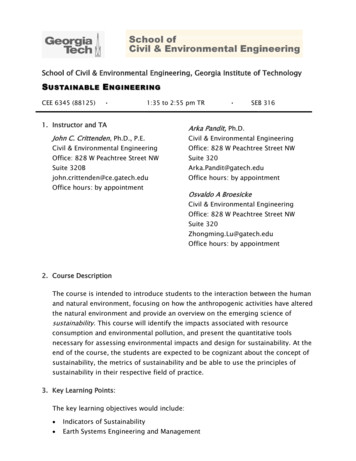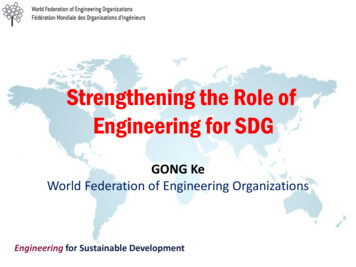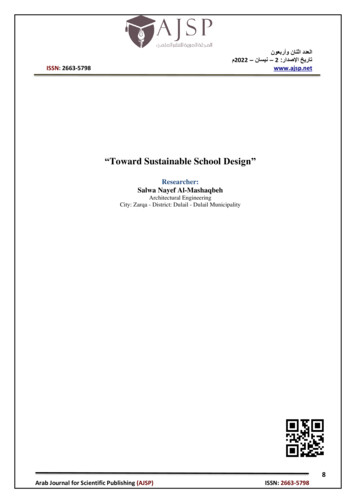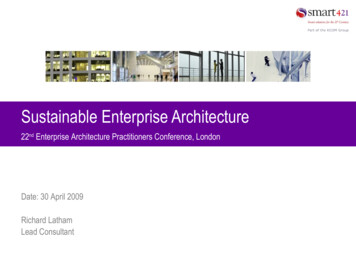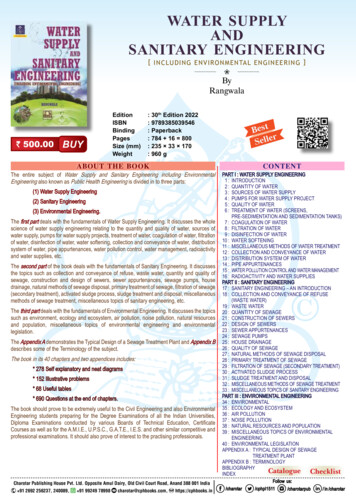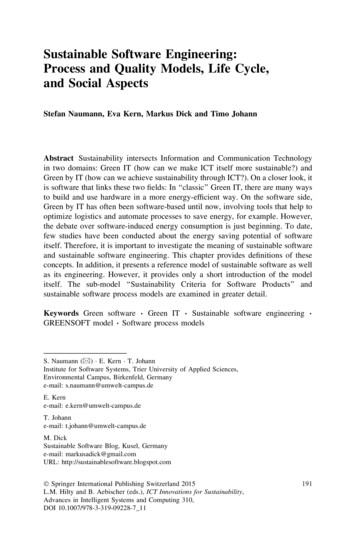
Transcription
Sustainable Software Engineering:Process and Quality Models, Life Cycle,and Social AspectsStefan Naumann, Eva Kern, Markus Dick and Timo JohannAbstract Sustainability intersects Information and Communication Technologyin two domains: Green IT (how can we make ICT itself more sustainable?) andGreen by IT (how can we achieve sustainability through ICT?). On a closer look, itis software that links these two fields: In ‘‘classic’’ Green IT, there are many waysto build and use hardware in a more energy-efficient way. On the software side,Green by IT has often been software-based until now, involving tools that help tooptimize logistics and automate processes to save energy, for example. However,the debate over software-induced energy consumption is just beginning. To date,few studies have been conducted about the energy saving potential of softwareitself. Therefore, it is important to investigate the meaning of sustainable softwareand sustainable software engineering. This chapter provides definitions of theseconcepts. In addition, it presents a reference model of sustainable software as wellas its engineering. However, it provides only a short introduction of the modelitself. The sub-model ‘‘Sustainability Criteria for Software Products’’ andsustainable software process models are examined in greater detail.!!Keywords Green softwareGreen ITSustainable software engineeringGREENSOFT model Software process models!!S. Naumann (&) ! E. Kern ! T. JohannInstitute for Software Systems, Trier University of Applied Sciences,Environmental Campus, Birkenfeld, Germanye-mail: s.naumann@umwelt-campus.deE. Kerne-mail: e.kern@umwelt-campus.deT. Johanne-mail: t.johann@umwelt-campus.deM. DickSustainable Software Blog, Kusel, Germanye-mail: markusadick@gmail.comURL: http://sustainablesoftware.blogspot.com! Springer International Publishing Switzerland 2015L.M. Hilty and B. Aebischer (eds.), ICT Innovations for Sustainability,Advances in Intelligent Systems and Computing 310,DOI 10.1007/978-3-319-09228-7 11191
192S. Naumann et al.1 Introduction and MotivationGreen IT and Green by IT are common terms in the debate over ICT andsustainability. Green by IT (also: Green through IT) covers the support of sustainable development by means of ICT. This includes for example software thatreduces environmental problems through optimization. Green IT (also: Green inIT) denotes actions through which ICT itself could become more sustainable. Thisconcerns hardware and software, where the hardware part is common knowledge.The software side, by contrast, is still the subject of current research projects. Here,two main questions are being investigated: What is sustainable software, andhow can software be produced in a sustainable way? The first question dealswith quality characteristics concerning the energy consumption of software, forexample. Since software is a very complex product in its architecture, functionalities, and usage, this is not an easy task. The second question concerns theprocess of software engineering and how it can be improved in order to producesustainable software in a sustainable way.In this chapter, we present a model for sustainable software and its engineering,as well as an approach to defining sustainability characteristics for softwareproducts and a software life cycle.2 What Is Sustainable Software Engineering?In order to classify issues in sustainable software and its engineering, we providesome definitions.First we define Sustainable Software as software whose development, deployment, and usage results in minimal direct and indirect negative impacts or evenpositive impacts on the economy, society, human beings, and the environment [1].A prerequisite for sustainable software is a sustainable development process,which refers to the consideration of environmental and other impacts during thesoftware life cycle and the pursuit of the goals of sustainable development.Building on this we can define Sustainable Software Engineering as the artof developing sustainable software through a sustainable software engineeringprocess. In this, software products must be defined and developed in such a waythat the negative and positive impacts on sustainable development that result or areexpected to result from the software product over its whole life cycle are continuously assessed, documented, and used for further optimization of the softwareproduct [1].Both of these definitions are based on product life cycles in terms of Life CycleAssessment (abbr. LCA) or a cradle-to-grave approach. Additionally, Lami et al.assert that a (Green and) Sustainable Software Process is a ‘‘software process thatmeets its (realistic) sustainability objectives, expressed in terms of direct andindirect impacts on economy, society, human beings, and environment that resultfrom its definition and deployment’’ [2].
Sustainable Software Engineering 193Fig. 1 The GREENSOFT reference model [3]Summarizing these definitions, a sustainable software product ideally meetsthree conditions: The software is produced in a way that meets sustainability objectives. The software has minimal negative social and environmental impacts during itsusage (first-order effects). The software functionality reinforces sustainable development or at least has nonegative impacts on the society or environment (second-order and systemiceffects).The GREENSOFT Model (Fig. 1) classifies and sorts the described characteristicsof sustainable software and its engineering [1]. This reference model contains fourparts: the life cycle of software products; criteria and metrics that represent andmeasure sustainability aspects directly and indirectly related to the softwareproduct; procedure models for the different phases; and recommendations foraction as well as tools. The model is described in detail in [1].3 Related WorkBased on the definitions in Sect. 2 and the GREENSOFT Model, we summarizerelated work. A good overview of sustainable software engineering can be found in[4]: here, the author gathered 96 relevant publications on sustainable softwareengineering. They also discussed the question of what sustainability means in (andfor) software engineering [5]. Amsel et al. [6] assert that sustainable software
194S. Naumann et al.engineering should develop software that meets the needs of users while reducingenvironmental impacts.A methodology to measure and incrementally improve the sustainability ofsoftware projects has been presented by Albertao et al. [7]. They advise implementing sustainable aspects continuously throughout the assessment phase,reflection phase, and goal improvement phase. In order to make the differentsustainability issues manageable, they describe properties of a quality model,which they develop further in a later work that considers the overall softwareprocess [8]. Calero et al. [9] examine such software quality standards in greaterdetail, examining how they could reinforce sustainability.Agarwal et al. [10] analyze and discuss the possibilities and benefits of greensoftware. One of their findings is that more efficient algorithms will take less timeto execute and thus support sustainability overall. In addition, they presentmethods to develop software in a sustainable way, compare them to conventionalmethods, and list some further environmentally friendly best practices for thedevelopment and implementation of software systems.Based on the life cycle of software, Taina proposes metrics [11] and a methodto calculate software’s carbon footprint [12]. To do so, he analyzes the impacts ofeach software development phase for a generic project. The resulting carbonfootprint is mainly influenced by the development phase, but also by the way it isdelivered and how it will be used by the customers. Lami et al. [2] define softwaresustainability from a process-centric perspective. They define processes in a waythat they can be measured in terms of process capability according to the ISO/IEC15504 standard. They also distinguish between the sustainability factors power,paper, and fuel consumption. Dick et al. [13] discuss how particularly agilemethods could improve sustainability in software engineering processes.Another approach to Green Software Development is presented by Shenoy andEeratta [14]. They also take the whole life cycle of software into account and offersuggestions for the typical development phases of software. Käfer [15] also presents conceptual and architectural issues concerning software energy consumptionas well as ideas for incorporating energy efficiency issues into software projects.Mahaux [16], Penzenstadler [17] and Kocak [18] consider requirements forengineering, while Sahin [19] and Shojaee [20] look at the design of energyefficient software.4 A Quality Model for Sustainable SoftwareIn order to decide whether or not software is sustainable, appropriate criteria arerequired. A first approach to developing these is offered by the Quality Model forSustainable Software, presented in the following section. Overall, the differentaspects can be grouped into common criteria, directly related criteria, and indirectly related criteria and metrics, as pictured in our Quality Model for SustainableSoftware (Fig. 2).
Sustainable Software Engineering 195Fig. 2 Quality model for sustainable software [3]Common Quality Criteria. The common criteria arise from the well known andstandardized quality aspects for software, issued by the International Organizationfor Standardization [21]. The proposed quality model takes such aspects intoaccount as Efficiency, Reusability, Modifiability, and Usability. These qualityaspects extend to the field of sustainable development [8].The quality aspects belonging to Efficiency are Runtime Efficiency, CPUIntensity, Memory Usage, Peripheral Intensity, Idleness, and Number of Methods.Runtime Efficiency considers the time needed to finish executing depending on itsimplementation. In this context, Capra et al. [22] present the relation betweenfaster application and higher energy consumption. The aspects CPU-Intensity,Memory Usage and Peripheral Intensity cover the resource utilization caused bysoftware execution. In fact, the effects of the intensity of the resource consumptionon the resulting energy consumption or even on system durability need to beanalyzed. Idleness describes how often the system is idle. This aspect is relevant tocertain types of software systems, such as virtual servers [11]. The total Number ofMethods reflects the size of applications [22].
196S. Naumann et al.Directly Related Criteria. In contrast to common efficiency criteria, which canbe considered as indicators of energy efficiency [23, 24], the energy efficiency of asystem itself can be ranked in a reference system [25, 26]. This means its goal is tooptimize the energy consumption in relation to delivered service items. Thus, thequality criterion Energy Efficiency, belonging to Efficiency in general, is assignedto the directly related criteria [1]. The Framework Entropy represents the grade ofusage of external libraries and high level constructs. The different types ofapplications with their different levels of energy efficiency are indicated by thecriterion Functional Types [22].Hardware Obsolescence [1, 8, 27] considers the amount of hardware that needsto be replaced before the sustainably worthwhile lifetime is reached, due tosoftware with higher system requirements. This criterion goes together with thequality aspect Adaptability. Both aspects belong to the criterion Portability. Here,Adaptability describes the possibilities to adapt the software to the specific consumer needs.The quality criterion Feasibility evaluates the effects of the product development, or rather the software engineering process, on sustainable development. Inthis context, Travel includes business trips that belong to a software project and,where appropriate, the daily trips to work [8]. The resulting Carbon Footprintspecifies the amount of CO2 emissions caused by software development in thecourse of the software’s life cycle [12]. The aspect Energy Consumption indicatesthe consumed energy caused by software development. Waste counts the resourcesconsumed during software development for activities that do not have any additional value for customers or end users [11]. The aspect Infrastructure accounts forthe conditions facilitating the usage of the software product.From the perspective of the social aspects of sustainable development, there maybe more qualities that require special measurements and assessment methods. As afirst step, these aspects are called Accessibility, Usability and Organization Sustainability. Whereas Accessibility and Usability are well known aspects in softwareengineering, the sustainability of the organization is usually not considered incommon software engineering processes and software’s life cycle. Accessibilityindicates whether the software product can be used by as many people as possiblewithout any restrictions. Usability covers the understandability, learnability andoperability of a software product, i.e. if the software usage is user-friendly andeasily learned. The aspect Organization Sustainability covers the social situation inthe software company, including working conditions, for example.Indirectly Related Criteria. By using software, resources and energy can bereduced in other branches or application domains. Hence, criteria indirectly relatedto the software product itself also need to be considered.Product Sustainability summarizes the effects of software on other products andservices. It covers effects of usage, as well as systemic effects. The followingaspects are presented by Taina [11]: Fit for Purpose takes the fitness of softwarefor its specific operation purpose into account. The contribution of software within
Sustainable Software Engineering 197its application domain to reducing emissions, waste, and the like is indicated bythe aspect Reduction. Beauty aims to value the software for its contribution tosustainable development [11]. Indeed, since a reference system is required to havea comparative figure, the exact quantification of these aspects may be difficult.According to Taina [11], the quality Reflectivity refers to the quality aspect ofefficiency. It specifies the manner in which the usage of software influences theresources that are indirectly needed by other persons or systems. Since the aspectReflectivity does not belong to the first-order effects or the efficiency effects of ICTin the proper sense of the term but counts as an effect of use, it is indicated as astandalone quality of the indirectly related criteria. However, more research isrequired in this field in order to take into account user behavior and usagescenarios.5 Process Models of Sustainable Software EngineeringAccording to our definitions, the precondition for creating software products thatmeet the presented sustainability criteria is a software engineering process thatmeets sustainability objectives. Hence, corresponding process models are needed.In the following, different approaches for such models will be presented andcompared. First, we provide a description of the process-centric software sustainability according to Lami et al. [2], which defines a set of reference processesto be applied during sustainable software development life cycles. Then, wedescribe our process model for sustainable software development [13] and thegreen model for sustainable software engineering by Mahmoud and Ahmad [28].These two models are checked for their compliance with the reference processesby Lami et al. [2], in order to determine which reference processes are covered bythe models and which ones are missing.5.1 Process-Centric Software SustainabilityLami et al. [2] define a set of high-level reference processes which add sustainability concepts to the software reference processes defined in ISO/IEC 12207. Thestandard reference processes describe all activities directly and indirectly related todevelopment, maintenance, and operation of software.Lami et al. point out that processes regarding sustainability are missing in ISO/IEC 12207. Therefore, they define a set of three complementary sustainabilityprocesses: Sustainability Management Process, Sustainability Engineering Processand Sustainability Qualification Process.These additional reference processes aim at continuously improving thesustainability of both software products and software processes. According to their
198S. Naumann et al.definition of green and sustainable software processes, a process is sustainable ifits impacts on sustainability are small (see definitions in Sect. 2).Sustainability Management Process. The management process includes a preliminary phase, a planning phase, a monitoring phase, and a supplier sustainabilitycontrol. In the preliminary phase, the principles and criteria for sustainability areestablished. In the planning phase, sustainability activities of the developmentprocess are indicated, and the corresponding requirements as well as necessaryresources are planned. Afterwards, the sustainability of the deployed activities andtheir conformity with the requirements are monitored. The last part of the management process (supplier sustainability control) deals with sustainability policiesand requirements for supplied products and services. Here, an agreement needs tobe found and the supplier’s sustainability needs to be monitored.Sustainability Engineering Process. The engineering process is concerned withsuitable tools and methods to enable and support a sustainable development process. In this context, sustainable issues and green principles for the developmentare defined, applied, and analyzed. The energy and resource consumption arefactors that impact the sustainability and thus should be identified at the start of theengineering process. In the next step, the impacts of these effects should be analyzed in order to subsequently set sustainability objectives for the developmentprocess. In addition to the impacts of the process itself, the impacts of changerequests on sustainability should be determined.Sustainability Qualification Process. The qualification process applies toexternal resources such as engineering and management support tools. Aimed atsustainable products, these external resources need to be sustainable as well. Inorder to ensure their quality, a qualification strategy, an implementation plan forthe strategy, documentation of the outcomes of the qualification, and a qualification report are required.5.2 A Process Model for Agile and Sustainable SoftwareEngineeringThe Software Process Enhancement for Agile and Sustainable Software Engineering (GSSE) [13] was presented as an exemplary process that fits into theprocedure model part of the GREENSOFT model (Fig. 1). It is not a completesoftware development process, but it claims to be adaptable to any processregardless of whether it works with iterations, phases or both. The only requirement is the possibility to inject its activities repetitively into the target process.
Sustainable Software Engineering 199The enhancement is claimed to be lightweight. There are only two main activitiesthat constitute the process: Process Assessment and Sustainability Reviews andPreviews. The focus of Process Assessment is the sustainability of the softwaredevelopment process itself. The sustainability of the software product is addressedwith Reviews and Previews. Both activities rely on a schematic life cycle model,inspired by life cycle assessment that denotes different impacts and effects ofsoftware on sustainable development that should be addressed.The process distinguishes between three roles: the Customer Representative,the Development Team, and the Sustainability Executive. The Customer Representative represents the organization or the users who finance and use the software.The Development Team is responsible for developing the software as well as forimproving the software with regard to sustainability-related non-functionalrequirements. The Sustainability Executive is responsible for continuous ProcessAssessment, organizing the Review and Preview meetings, and compiling a finalreport with the key figures and findings of Reviews, Previews and ProcessAssessment.Process Assessment is a continuous activity alongside the software development process. It is meant to collect and edit data from the process that can be usedfor a carbon footprint calculation or even for life cycle assessment. The followingdata may be monitored and collected: Data regarding energy for running thedeveloper’s offices and IT infrastructure and for monitoring the means of travel forbusiness trips and commuting, as well as the quantity of used stationery, e.g. paperfor reports [29]. During the software development process, Process Assessmentshould briefly report to Reviews and Previews to keep the developers informed.Sustainability Reviews and Previews focus on the software under developmentto optimize it in terms of its impacts and effects on sustainable development.During development, several Review and Preview meetings are conducted, e.g.after two-thirds of an iteration, which establishes a continuous improvement cycle.In reviews, the recent work is examined for any sustainability issues and solutionsare then drawn up together with the expected rate of improvement, which is thepreview part. In the subsequent Review and Preview session, these solutions areassessed to determine whether or not the issues have been addressed. Therefore,developers need methods and figures to explore these issues. In [13] a method tomeasure the energy efficiency of software is proposed that is based on unit testing.Other methods may be appropriate as well, because from a life cycle perspective,energy consumption is only one issue. Other aspects are resource and hardwarerequirements, accessibility, or even usage effects such as substitution, dematerialization, and rebound effects (cf. Fig. 2). Therefore, Reviews and Previews shouldalready start in early process stages when the software product is defined [29]. Theinput from Process Assessment should be considered if there are issues that can besolved by the attendees themselves (e.g. chosen means of travel or local energyconsumption).At the end of the software development project, a report including the outcomesand key findings of Process Assessment (maybe a carbon footprint calculation) as
200S. Naumann et al.well as Reviews and Previews should be handed over to the customer representatives. Additionally, outstanding results, lessons learned, and best practicesshould be preserved in a knowledge base to be available to other projects.5.3 A Green Model for Sustainable Software EngineeringThe Green Model for Sustainable Software Engineering (GSEP) [28] is inspired bythe GREENSOFT Model. It is a two-level model that comes with a completeGreen Software Engineering Process in the first level and a collection of exemplary software tools, promoting green computing in the second level. In the following, we provide a short overview of the engineering process. The processclaims to combine the advantages of sequential, iterative, and agile softwareprocesses to produce a more sustainable one. The single phases of the process areeither green processes or there are at least green guidelines.The process consists of nine successive phases: Requirements, Design, UnitTesting, Implementation, System Testing, Green Analysis, Usage, Maintenance,and Disposal. As can be seen, the traditional phases of sequential software processes are extended with Green Analysis, Usage, and Disposal. An incrementmilestone can be set between Implementation and System Testing. The systemrelease milestone occurs between Green Analysis and Usage. The process flowexplicitly models possibilities to return to Requirements from Unit Testing,System Testing, Green Analysis, and Maintenance.The Requirements phase is the most critical and important phase for theresulting greenness of a software product, because the requirements define thebasic features and thus affect all the following phases. Hence, it is important thatthe requirements consider green issues and objectives. The requirements phaseincludes a risk assessment activity in terms of energy efficiency as well as arequirements test activity. If any issues are discovered during these activities, theRequirement phase may be started again.The Design phase develops the system architecture based on the requirements.Three design decision guidelines are provided to support architects: (1) outline acompact design of data structures and efficient algorithms (however, a betterperformance does not necessarily result in a higher energy efficiency), (2) designsmart and efficient functionality (results in an efficient algorithm and fewer lines ofcode during implementation), and (3) decide carefully which frameworks andexternal libraries are necessary (additional layers may cause additional processingtime but may also simplify software engineers’ work). Components should bereused if possible (requires less energy-consuming development efforts). If reusedcomponents do not meet the energy efficiency requirements, they should bereorganized to conform to these requirements. The Implementation phase isdescribed together with the Design phase and does not come with any furtherprocess descriptions, since it depends on the Design phase.
Sustainable Software Engineering 201Following Mahmoud et al., the Unit Testing phase comes before Implementation because if non-conformance with the requirements is encountered here, lessenergy is consumed if the process steps back to the Requirements phase than ifUnit Testing comes after the Implementation. However, this does not mean thatUnit Tests during the Implementation phase are not allowed. After Implementationand System Testing, the Green Analysis phase is performed. This phase determines the greenness of each increment by applying specific metrics to thedeveloped code.As an example of green performance indicators that characterize the greennessof each stage in the software engineering process, Mahmoud et al. suggest performance or CPU usage. The identified energy usages should be mapped to thesource code to optimize the affected algorithms. Afterwards it is decided whethereven (small) changes in requirements are necessary in order to optimize energyusage. In fact, this means that the process may step back to Requirements in orderto add missing requirements, correct misunderstandings during the Requirementphase and in this way optimize the product. They argue that this step back isacceptable if it results in less severe mistakes. If only changes to the source codeare necessary, these are directly implemented within this phase without steppingback.Whereas Requirements, Design, Implementation, the Testing phases, and theGreen Analysis phase come with some process and workflow descriptions, Usage,Maintenance, and Disposal come only with a set of general guidelines.5.4 Comparison of the Process ModelsIn the following, we compare how Mahmoud and Ahmad’s [28] Green SoftwareEngineering Process (GSEP, see Sect. 5.3) and the process enhancement for agileand Sustainable Software Engineering (GSSE, see Sect. 5.2) by Dick et al. [13]implement the reference processes for green and sustainable software defined byLami et al.Both GSSE and GSEP processes implement only the Planning phase of theSustainability Management Process. GSEP explicitly defines different sequentialphases, including a specialized Green Analysis phase, as well as the possibility ofhaving several iterations. It is necessary to plan the number of iterations and toschedule different activities connected to the Green Analysis phase. The same istrue for GSSE, where the Reviews and Previews have to be scheduled aftertwo-thirds of an iteration or phase. More specifically, the Sustainability Executiveis responsible for organizing the sustainability-centric activities, which obviouslyinclude time planning as well as resource allocation. For the other phases of thereference process, the Preliminary phase, Monitoring phase, and Supplier Sustainability Control, no equivalents could be spotted in either GSEP or in GSSE.The Sustainability Engineering Process is implemented by GSEP and GSSEand both processes supply the defined outcomes. GSEP identifies factors that affect
202S. Naumann et al.sustainability explicitly within requirements engineering, whereas GSSE references a schematic Life Cycle model of software products that has the sole purposeof collating exemplary effects and impacts on sustainable development with lifecycle phases known from Life Cycle Analysis (manufacturing, distribution, usage,end of life). Both processes perform sustainability analysis to determine the impactof the sustainability factors. GSEP has the Requirements and the Green Analysisphase and GSSE has the Reviews and Previews as well as Process Assessment.GSEP explicitly defines sustainability objectives in Requirements, whereas GSSEmentions sustainability objectives implicitly together with the role of the Development Team. The team is responsible for the non-functional requirements [13]and is therefore responsible to drive the Reviews and Previews. Exactly where thesustainability objectives as non-functional requirements are defined is left byGSSE to the specific implementation of the target process. GSEP and GSSE referto principles and guidelines that are helpful to find adequate techniques andmethods appropriate to accomplishing the sustainability objectives. Regarding thetechniques and methods for sustainability, GSEP defines a large group of metricsand tools in its second level. GSSE mentions a carbon footprint calculation andespecially methods and metrics to measure and assess the energy efficiency ofsoftware. The reference process requires an analys
sustainable software process models are examined in greater detail. Keywords Green software! Green IT! Sustainable software engineering! GREENSOFT model!Software process models S. Naumann (&) ! E. Kern ! T. Johann Institute for Software Systems, Trier University of Applied Sciences, Environmental Campus, Birkenfeld, Germany e-mail: s.naumann .

